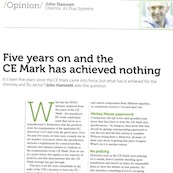

News

Five years on and what has the CE Mark achieved?
03/07/2018
It’s been five years since the CE Mark became mandatory and A1 Director John Hamnett's article in the latest edition of H&V News asks: what it has achieved?
Here's the article in full.
Let’s start with the good news. Over the last five years, we have seen a steady rise in the number of projects where the specification includes a requirement for commercial flue, chimney and exhaust systems to conform to the requirements of the CE Mark. Now we’re at a point where this applies to the majority of projects, and this demonstrates that the CE Mark message has got through.
That’s all the more remarkable in the wake of the UK’s decision to leave the European Union because there was a lot of industry chatter about the CE Mark rulebook being thrown out of the window in favour of a series of new British Standards – and maybe the re-emergence of the Kitemark.
The reality is that the CE Mark is here to stay – whether we’re inside or outside of the EU – because the introduction of the CE Mark was such a big sea change for the construction industry that there’s no appetite for another seismic change again soon.
However, despite awareness of the CE Mark, in my opinion, it still hasn’t achieved anything for three key reasons:
1. The industry is still cutting corners
The majority of UK flue firms import the bulk of their components from within Europe and assemble systems based on the parts they can order. It’s a bit like building a system using LEGO – which is all well and good when they’re putting together a straightforward system for a straightforward building. If there isn’t a LEGO part to fit, then they’ll do a bit of metal bashing and make up any missing parts to complete the system. As if that wasn’t bad enough, some firms will mix and match components from different suppliers, so contractors get a proper ‘cut-and-shut’ job.
We remain the only UK company to have secured a CE Mark for a complete system – even though the CE Mark has been in force for five years – and that tells you everything you need to know about the state of the industry.
2. Mickey Mouse paperwork
Contractors, QSs and specifiers may know that they have to write the CE Mark into specifications – by doing so, they know that they should be getting corresponding paperwork to tick the box that the flue system is complete.
Without doing them a disservice, all they care about is getting that piece of paper.
What’s on it is another matter: it could be my daughter’s drawing of Mickey Mouse for all the good it will do them. The CE Mark paperwork is something of a minefield, and, in truth, you’d have to have studied it in depth to fully understand it – and we know that contractors, QSs and specifiers simply haven’t got the time to do that. All they’re looking for is something that says ‘CE Mark’ and a vague explanation of a flue system.
This is where many firms get away with their metal bashing or ‘cut and shuts’ because they have a one-size-fits-all piece of paper.
It does beg the question: what’s the point of having the paperwork if nobody understands it?
3. No policing
Directives such as the CE Mark need policing. As it stands, there’s nobody checking up on installations or acting as a place for responsible firms to blow the whistle on bad practice. It makes you wonder: why introduce something if you’re not going to enforce it? The bureaucrats who introduced the CE Mark will say it will help the industry to self-police, but that’s just like giving the fox a key to the hen house!
Interestingly, we have seen a rise in private policing. One brand has started creeping into specifications on some projects; if it’s not used, contractors are having to strip out the non-branded products and install the branded items – at their own expense.
This is clearly a commercial relationship between the brand and a contractor, but it’s made more people in our industry sit up and take more notice of it (mainly because they could be hit where it hurts the most: in the pocket) than anything the CE Mark has done.
Is it better to have private policing than no policing at all?
